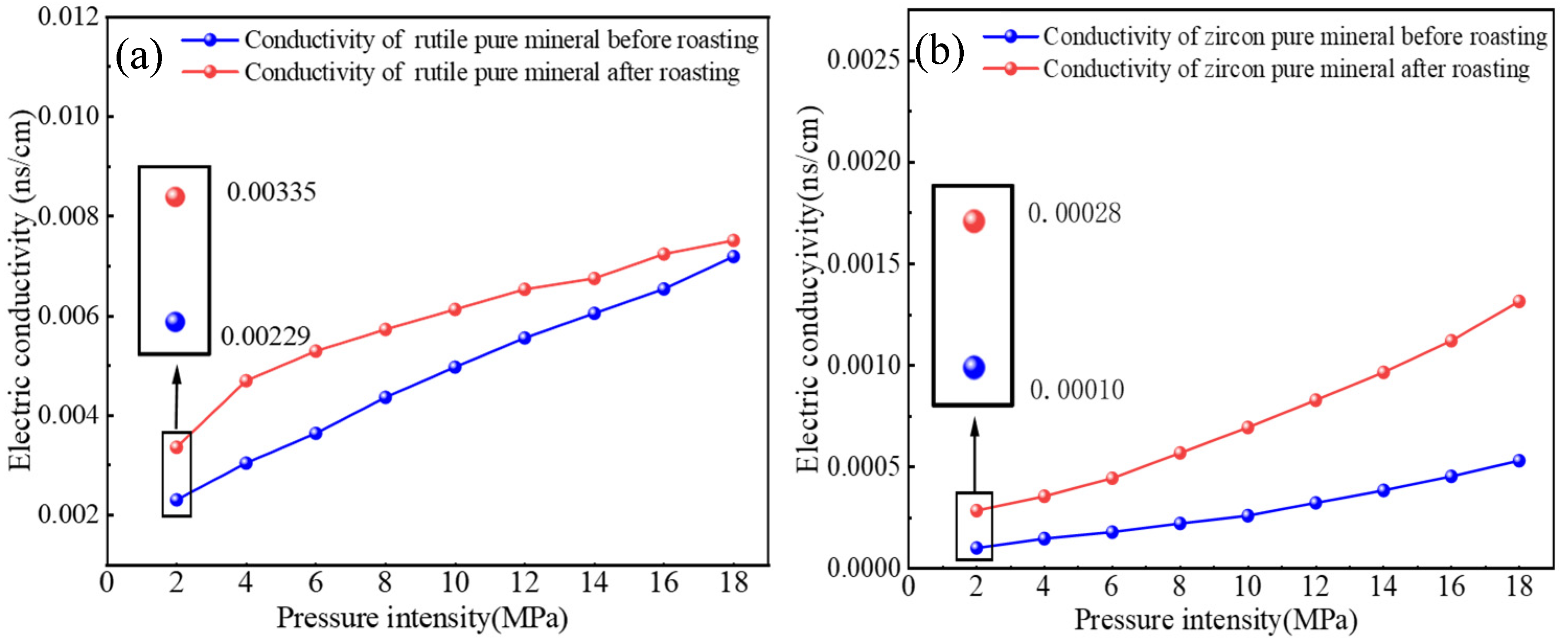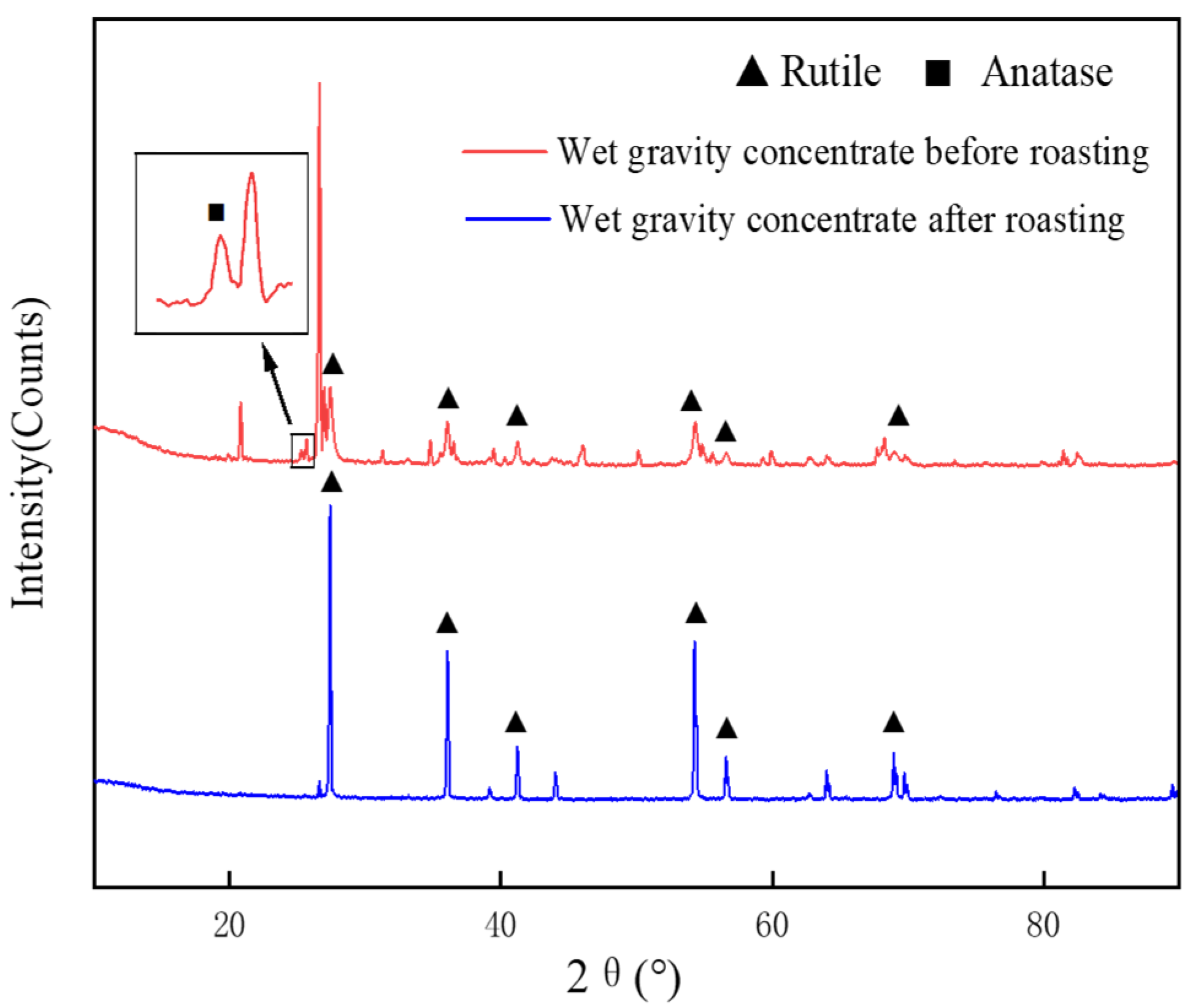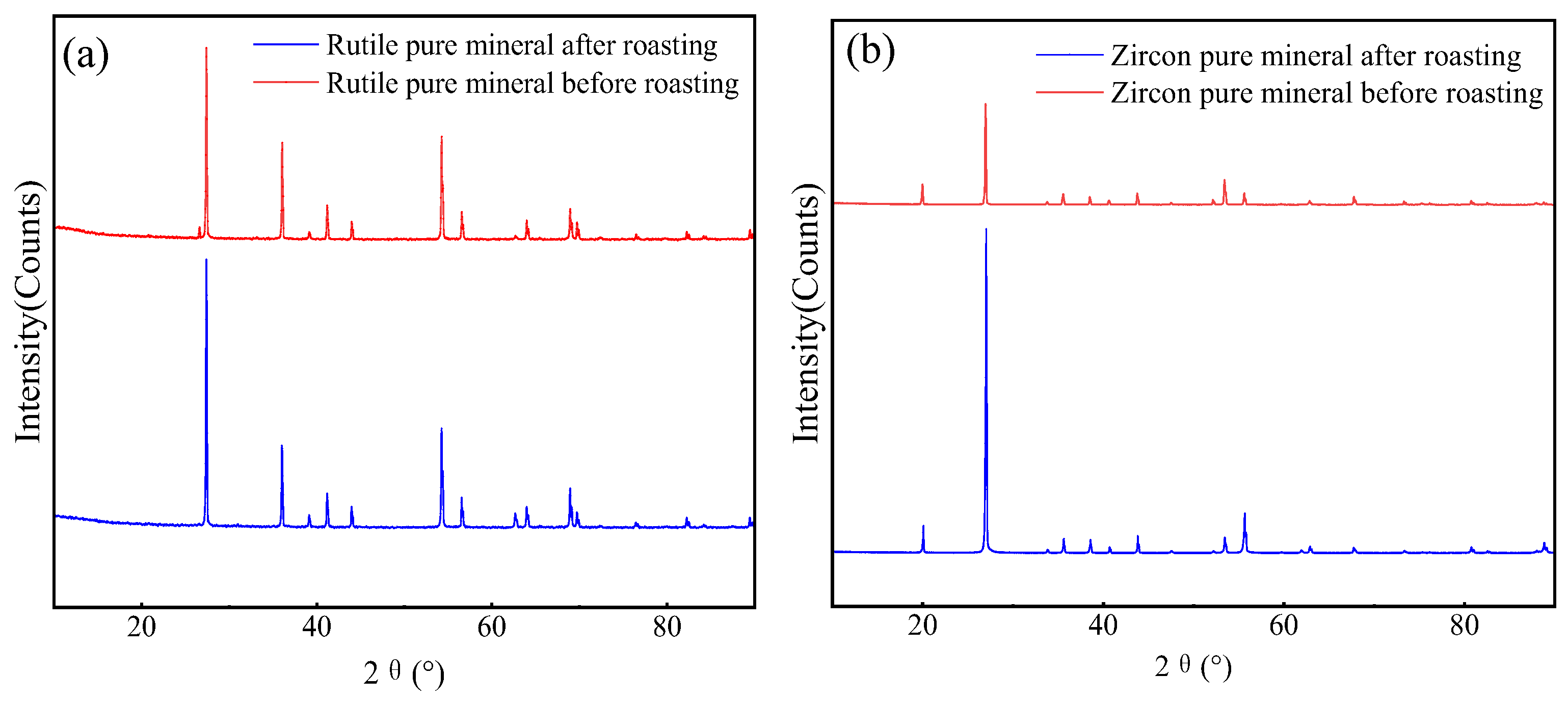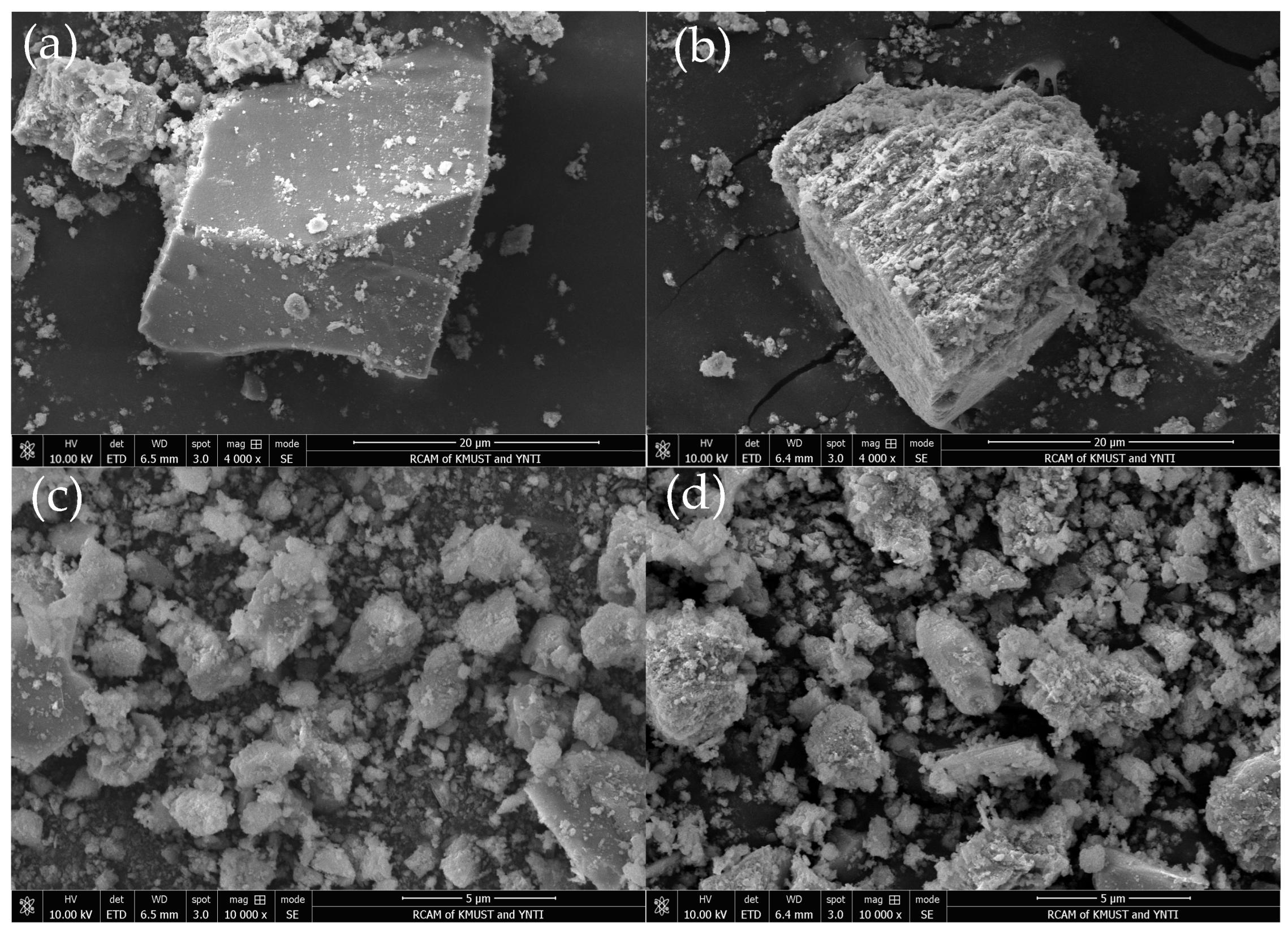Experimental Study on Electric Separation of Ti/Zr-Bearing Minerals in Gravity Separation Concentrate After Thermal Activation Roasting
Abstract
1. Introduction
2. Materials and Methods
2.1. Materials
2.2. Methods
3. Results and Discussion
3.1. TAR Enhancing the ES
3.2. EC Measurements
3.3. Phase Evolution Laws of the Samples
3.4. SEM Measurements
4. Conclusions
Author Contributions
Funding
Data Availability Statement
Acknowledgments
Conflicts of Interest
References
- Meinhold, G. Rutile and its applications in earth sciences. Earth-Sci. Rev. 2010, 102, 1–28. [Google Scholar]
- Qiu, G.; Guo, Y. Current situation and development trend of titanium metal industry in China. Int. J. Miner. Metall. Mater. 2022, 29, 599–610. [Google Scholar] [CrossRef]
- Farjana, S.H.; Huda, N.; Mahmud, M.A.P.; Lang, C. Towards sustainable TiO2 production: An investigation of environmental impacts of ilmenite and rutile processing routes in Australia. J. Clean. Prod. 2018, 196, 1016–1025. [Google Scholar] [CrossRef]
- Song, P.; Ren, L.; Bao, S.; Zhang, Y.; Qin, W.; Nguyen, A.V.; Chen, B. Influence of SHMP concentration on rutile flotation in BHA system: Guiding the separation of rutile and hornblende. Langmuir 2024, 40, 23930–23938. [Google Scholar] [CrossRef] [PubMed]
- Wang, H.; Zhang, X.; Qu, R.; Zhang, L.; Li, W. Recent technology developments in beneficiation and enrichment of ilmenite: A review. Miner. Eng. 2024, 219, 109084. [Google Scholar] [CrossRef]
- Rejith, R.G.; Sundararajan, M. Combined magnetic, electrostatic, and gravity separation techniques for recovering strategic heavy minerals from beach sands. Mar. Georesources Geotechnol. 2018, 36, 959–965. [Google Scholar] [CrossRef]
- Premaratne, W.; Rowson, N. Recovery of titanium from beach sand by physical separation. Eur. J. Miner. Process. Environ. Prot. 2004, 4, 183–193. [Google Scholar]
- Routray, S.; Rao, R.B. Beneficiation and characterization of detrital zircons from beach sand and red sediments in India. J. Miner. Mater. Charact. Eng. 2011, 10, 1409–1428. [Google Scholar] [CrossRef]
- Okoli, B.I.; Agboola, O.A.; Onwualu, A.P.; Bello, A.; Sholiyi, O.S.; Anye, V.C.; Yusuf, O.T. Zirconia enrichment of zircon from Arikya, Nasarawa State, Nigeria, by magnetic and gravity separation processes for use as reinforcing agent in composite formulation. Eng 2024, 5, 180–197. [Google Scholar] [CrossRef]
- Li, C.-F.; Hu, Z.-Y.; Li, W.; Li, Y.; Su, B.-L. Direct observation of the TiO2 anatase-rutile phase transition by in-situ transmission electron microscopy. Mater. Charact. 2025, 227, 115226. [Google Scholar] [CrossRef]
- Sanehira, Y.; Shibayama, N.; Numata, Y.; Ikegami, M.; Miyasaka, T. Low-Temperature Synthesized Nb-Doped TiO2 Electron Transport Layer Enabling High-Efficiency Perovskite Solar Cells by Band Alignment Tuning. ACS Appl. Mater. Interfaces 2020, 12, 15175–15182. [Google Scholar] [CrossRef] [PubMed]
- Wang, Z.; Zheng, Y.; Huang, X.; Wang, X.; Peng, J.; Dai, Z. Gravity Separation Tests of a Complex Rutile Ore. Minerals 2024, 14, 68. [Google Scholar] [CrossRef]
- Zheng, Y.X.; Wang, Z.X.; Peng, J.L.; Chang, S. An Enhanced Separation and Purification Method for a Complex and Refractory Titanium Sand Ore. CN202311617036.X, 29 November 2023. [Google Scholar]
- Wang, L.; Wang, H.J.; Li, T. In-situ X-ray diffraction study of anatase and rutile at high temperatures. Acta Phys. Sin. 2013, 62, 146402. [Google Scholar] [CrossRef]
- Lu, R.; Liu, C.; Wu, J.; Wu, Y.-X.; Zhang, Q.; Sun, Q. Investigation on the structure evolution of rutile TiO2 during calcination of mixed-salt-treated metatitanic acid. J. Cryst. Growth 2023, 602, 126985. [Google Scholar] [CrossRef]
- Kushwaha, A.; Khan, W.; AlQahtani, H.; Laref, A.; Monir, M.E.A.; Nya, F.T.; Chowdhury, S.; Alghamdi, E.A.; Huang, H.; Xiong, Y. First-principles assessments of the electronic, and magneto-optical characteristics of Fe–Mn co-doped anatase TiO2 for photo-catalysis applications. Solid State Commun. 2023, 360, 115059. [Google Scholar] [CrossRef]
- Luo, B.; Wang, W.; Wang, Q.; Ji, W.; Yu, G.; Liu, Z.; Zhao, Z.; Wang, X.; Wang, S.; Zhang, J. Facilitating ionic conductivity and interfacial stability via oxygen vacancies-enriched TiO2 microrods for composite polymer electrolytes. Chem. Eng. J. 2023, 460, 141329. [Google Scholar] [CrossRef]
- Jiang, X.; Zhang, Y.; Jiang, J.; Rong, Y.; Wang, Y.; Wu, Y.; Pan, C. Characterization of Oxygen Vacancy Associates within Hydrogenated TiO2: A Positron Annihilation Study. J. Phys. Chem. C 2012, 116, 22619–22624. [Google Scholar] [CrossRef]
- Zhao, B.; Lin, L.; Chen, C.; Chai, Y.; He, D. Research on the Phase Transition and Morphological Evolution Behaviors of Titania/Titanate Nanomaterials by Calcination Treatment. Acta Chim. Sin. 2013, 71, 93–101. [Google Scholar] [CrossRef][Green Version]
- Agartan, L.; Kapusuz, D.; Park, J.; Ozturk, A. Effect of initial water content and calcination temperature on photocatalytic properties of TiO2 nanopowders synthesized by the sol-gel process. Ceram. Int. 2015, 41, 12788–12797. [Google Scholar] [CrossRef]
- Hamidouche, M.; Bouaouadja, N.; Torrecillas, R.; Fantozzi, G. Thermomechanical behavior of a zircon–mullite composite. Ceram. Int. 2007, 33, 655–662. [Google Scholar] [CrossRef]








| Conditions | Products | Yield/% | Grade/% | Recovery/% | ||
|---|---|---|---|---|---|---|
| TiO2 | ZrO2 | TiO2 | ZrO2 | |||
| Before roasting | Magnetic concentrate I | 32.48 | 59.28 | 0.65 | 31.50 | 3.09 |
| Magnetic concentrate II | 4.13 | 35.41 | 0.74 | 2.39 | 0.45 | |
| Conductor I | 14.57 | 87.50 | 1.67 | 20.85 | 3.56 | |
| Midding I | 6.10 | 75.11 | 7.60 | 7.50 | 6.79 | |
| Midding II | 4.86 | 25.65 | 33.10 | 2.04 | 23.51 | |
| Midding III | 7.28 | 76.10 | 7.10 | 9.07 | 7.57 | |
| Tailing II | 9.06 | 15.50 | 27.10 | 2.30 | 35.90 | |
| Conductor II | 18.44 | 75.75 | 4.00 | 22.85 | 10.79 | |
| Midding IV | 3.08 | 29.70 | 18.50 | 1.50 | 8.35 | |
| Feeding | 100.00 | 61.12 | 6.84 | 100.00 | 100.00 | |
| After roasting | Magnetic concentrate I | 32.48 | 59.28 | 0.65 | 31.64 | 2.89 |
| Magnetic concentrate II | 4.13 | 35.41 | 0.74 | 2.41 | 0.42 | |
| Conductor I′ | 20.08 | 90.05 | 0.84 | 29.71 | 2.31 | |
| Midding I′ | 3.08 | 75.50 | 5.25 | 3.83 | 2.21 | |
| Midding II′ | 6.23 | 15.10 | 41.30 | 1.55 | 35.19 | |
| Midding III′ | 3.41 | 73.50 | 8.70 | 4.12 | 4.06 | |
| Midding IV | 3.08 | 29.70 | 18.50 | 1.51 | 7.80 | |
| Conductor II′ | 13.45 | 82.20 | 1.40 | 18.17 | 2.57 | |
| Tailing I | 4.99 | 55.15 | 13.40 | 4.52 | 9.13 | |
| Tailing II | 9.06 | 17.15 | 27.00 | 2.55 | 33.42 | |
| Feeding | 100.00 | 60.85 | 7.32 | 100.00 | 100.00 | |
Disclaimer/Publisher’s Note: The statements, opinions and data contained in all publications are solely those of the individual author(s) and contributor(s) and not of MDPI and/or the editor(s). MDPI and/or the editor(s) disclaim responsibility for any injury to people or property resulting from any ideas, methods, instructions or products referred to in the content. |
© 2025 by the authors. Licensee MDPI, Basel, Switzerland. This article is an open access article distributed under the terms and conditions of the Creative Commons Attribution (CC BY) license (https://creativecommons.org/licenses/by/4.0/).
Share and Cite
Wang, Y.; Zheng, Y.; Zhang, H.; Huang, X.; Wang, X.; Wang, Z. Experimental Study on Electric Separation of Ti/Zr-Bearing Minerals in Gravity Separation Concentrate After Thermal Activation Roasting. Metals 2025, 15, 1072. https://doi.org/10.3390/met15101072
Wang Y, Zheng Y, Zhang H, Huang X, Wang X, Wang Z. Experimental Study on Electric Separation of Ti/Zr-Bearing Minerals in Gravity Separation Concentrate After Thermal Activation Roasting. Metals. 2025; 15(10):1072. https://doi.org/10.3390/met15101072
Chicago/Turabian StyleWang, Yang, Yongxing Zheng, Hua Zhang, Xiang Huang, Xiangding Wang, and Zhenxing Wang. 2025. "Experimental Study on Electric Separation of Ti/Zr-Bearing Minerals in Gravity Separation Concentrate After Thermal Activation Roasting" Metals 15, no. 10: 1072. https://doi.org/10.3390/met15101072
APA StyleWang, Y., Zheng, Y., Zhang, H., Huang, X., Wang, X., & Wang, Z. (2025). Experimental Study on Electric Separation of Ti/Zr-Bearing Minerals in Gravity Separation Concentrate After Thermal Activation Roasting. Metals, 15(10), 1072. https://doi.org/10.3390/met15101072






